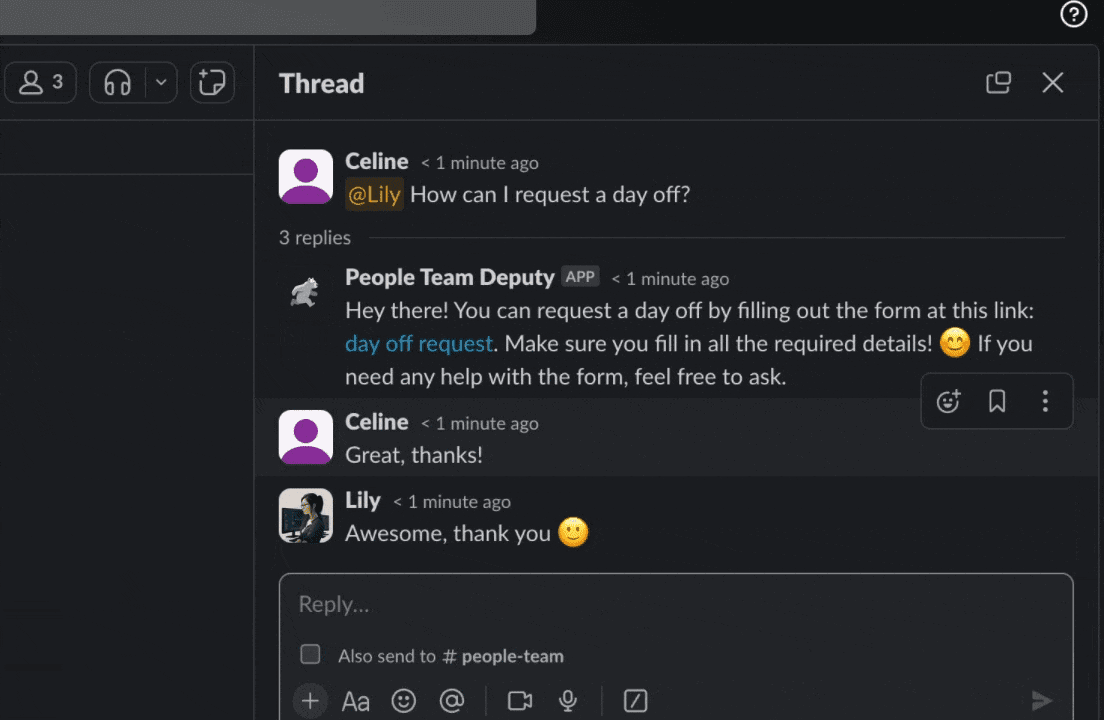Using OpenAI Assistants Function Calling: A Comprehensive Guide
Learn how to enhance OpenAI Assistants with function calling. This guide covers implementation, best practices, and practical applications using Runbear's no-code solution.
Function calling in OpenAI Assistants, similar to actions in GPTs, significantly enhances its capabilities. This feature allows your AI assistant to interact with external tools, APIs, and databases, making it more powerful and versatile. However, implementing function calls traditionally requires writing and executing code independently, often necessitating deployment in a separate location. This guide will explore function calling in depth and introduce solutions like Runbear that simplify this process.
Understanding OpenAI Assistants Function Calling
When using the OpenAI Assistant's API, you can define custom functions that extend the assistant's capabilities beyond language processing. The model can generate a JSON-structured object containing the required arguments to call these functions, creating a reliable bridge between the AI's abilities and external tools or APIs.
The Function Calling Process
- Function Definition: Define the function and its parameters in a JSON object.
- Execution: When an assistant is initiated with a run, it enters a
requires_actionstate after processing if it determines that a function call is necessary. - Output Submission: Use the submit_tool_outputs API to pass the output of your function back to the Assistant.
This process allows for a dynamic interaction between the AI model and external resources, enabling more complex and practical applications.
Leveraging OpenAPI for Function Calling
OpenAPI, a widely adopted API documentation specification, provides a structured way to represent API specs. This makes it an ideal choice for implementing function calling in OpenAI Assistants.
Example: Customer Insight API
Let's consider a practical example of an in-house API that displays top revenue customers for a specific product:
openapi: 3.0.0
info:
version: 1.0.0
title: Customers Insight API
servers:
- url: https://salesdata.example.com/api
paths:
/customers/top_revenue/{product}:
get:
summary: List Top Revenue Customers for a Product
description: Retrieves a list of customers, sorted by their revenue from a specific product in descending order.
parameters:
- name: product
in: path
required: true
description: The unique identifier or name of the product to retrieve top revenue customers for.
schema:
type: string
responses:
'200':
description: Successfully fetched a list of customers by top revenue for the specified product.
content:
application/json:
schema:
type: array
items:
$ref: '#/components/schemas/CustomerByRevenue'
components:
schemas:
CustomerByRevenue:
type: object
properties:
name:
type: string
description: The name of the customer.
revenue:
type: number
description: The customer's revenue.To use this API with OpenAI Assistants, you need to convert it into a function definition:
{
"name": "customers_top_revenue_by_product",
"description": "Retrieves a list of customers, sorted by their revenue from a specific product in descending order.",
"parameters": {
"type": "object",
"properties": {
"path_params": {
"type": "object",
"properties": {
"product": {
"type": "string"
}
},
"required": [
"product"
],
}
},
"required": [
"path_params"
]
}
}This function definition specifies that the product parameter is required. When you instruct your Assistant to provide customer revenue for a specific product, it will intelligently determine the appropriate value for the product parameter.
Executing the Function Call
Let's say a user enters the query: "Show me top customers and their revenue for our ecommerce product." The assistant will interpret this request and call the customers_top_revenue_by_product function with the the following argument:
{
"path_params": {
"product": "ecommerce"
}
}The assistant recognizes that "ecommerce" is the product in question and structures the function call accordingly. Once the function is called, it will interact with your API based on the OpenAPI specification, retrieve the data, and return the result to the Assistant.
This structured approach ensures that the AI can reliably interact with your internal systems, providing accurate and up-to-date information to users.
Streamlining Function Calling with Runbear
Runbear offers a solution to simplify the process of implementing function calling in OpenAI Assistants. Here's how Runbear streamlines this process:
- Direct OpenAPI Integration: You can paste your OpenAPI specification directly into Runbear.
- Automatic Function Conversion: Runbear converts the API spec into a callable function for your OpenAI Assistant.
- Autonomous Execution: If instructions are provided, the assistant can autonomously call the API and return the result.
This approach eliminates the need to write, run, or deploy code for function calling, as long as the function is defined as a REST API.

And that's it. You can now link your OpenAI Assistants to your preferred communication tool and enjoy it.

This example is created for demonstration purposes. Exercise caution when applying it to connect to an actual system. If you're automating actions such as canceling an order or sending messages to your customers based on user input, ensure that you include an additional confirmation step for your instructions.
Best Practices and Considerations
When implementing function calling, especially for actions that interact with real systems, consider the following:
- Security: Ensure that your API endpoints are properly secured and that the assistant has appropriate access levels.
- Error Handling: Implement robust error handling to manage cases where the API might fail or return unexpected results.
- Rate Limiting: Consider implementing rate limiting to prevent excessive API calls.
- Confirmation Steps: For critical actions (e.g., canceling orders, sending messages to customers), include an additional confirmation step in your instructions.
Practical Applications
Function calling in OpenAI Assistants can be applied to various use cases:
- Web Browsing: Enable your AI assistant to fetch real-time information from the internet. This could be useful for answering queries about current events, retrieving up-to-date product information, or gathering research data. Learn more about implementing web browsing with Runbear.
- Zapier AI Actions: Extend your AI's capabilities by connecting it to thousands of apps through Zapier. This opens up endless possibilities for automation and integration. Discover Zapier AI Actions.
For more ideas, check out our article on 11 practical use cases for AI assistants.
Conclusion
Function calling significantly enhances the capabilities of OpenAI Assistants, allowing for more complex and practical applications. By connecting your Assistant to internal APIs, you can create a versatile tool that efficiently manages a wide range of tasks.
For those looking to enhance their daily workflow without altering current work methods, consider using solutions like Runbear to connect OpenAI Assistants to Slack or Microsoft Teams. This approach allows you to optimize your workflow without the need for extensive coding or function deployment.
For more details, book a demo or check out our doc site.
Get Started
Ready to explore the possibilities of function calling with OpenAI Assistants? Here are some next steps:
- Explore the OpenAI Documentation: Familiarize yourself with the latest updates on function calling in the OpenAI API.
- Identify Potential Integrations: Consider which internal or external APIs could benefit your workflows.
- Experiment with Runbear: If you're looking for a no-code solution, try out Runbear's OpenAI Assistants integration.
- Start Small: Begin with a simple integration and gradually expand as you become more comfortable with the process.
- Join Our Community: Connect with other Runbear users and get support in our Discord community.
By leveraging function calling, you can create more powerful, efficient, and tailored AI assistants that truly enhance your productivity and decision-making processes. For more insights on building custom AI solutions, read our guide on creating AI for consulting clients.
or Get started now!


